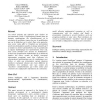Free Online Productivity Tools
i2Speak
i2Symbol
i2OCR
iTex2Img
iWeb2Print
iWeb2Shot
i2Type
iPdf2Split
iPdf2Merge
i2Bopomofo
i2Arabic
i2Style
i2Image
i2PDF
iLatex2Rtf
Sci2ools
ITS
2000
Springer
2000
Springer
Design Principles for a System to Teach Problem Solving by Modelling
This paper presents an approach to the design of a learning environment in a mathematical domain (elementary combinatorics) where problem solving is based more on modelling than on deduction or calculation. In this approach, we want to provide the student with a presentation which is close to the natural language formulations that she tends to give spontaneously, while ensuring a rigorous mathematical reasoning. To do so, we have introduced three modelling levels : first a mathematical formalisation of the students' intuitive process, then a conceptual and computational model allowing mathematical reasoning as well as communication with the student, and finally a presentation consisting in several interfaces, each one grouping problems ot some class. These interfaces are viewed as nondeterministic "machines" that the student uses to build a configuration satisfying some constraints. Keywords Intelligent tutoring system, Knowledge representation for instruction, interfac...
ITS 2000 | Mathematical Reasoning | Multimedia | Natural Language Formulations | Rigorous Mathematical Reasoning |
| Added | 25 Aug 2010 |
| Updated | 25 Aug 2010 |
| Type | Conference |
| Year | 2000 |
| Where | ITS |
| Authors | Gérard Tisseau, Hélène Giroire, Françoise Le Calvez, Marie Urtasun, Jacques Duma |
Comments (0)

